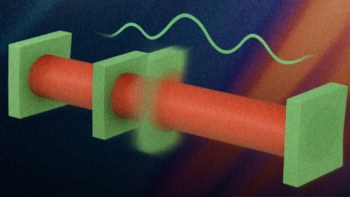
A butterfly flaps its wings on one side of the Earth and causes a tornado on the other – or so goes the popular illustration of chaos theory. But does chaos also exist in the tiny systems of the quantum world?
The answer is yes, according to researchers in the US and Canada who have now demonstrated quantum chaos in a system analogous to a disturbed spinning top, or a “kicked top”. The breakthrough could help in the understanding of the elusive transition between quantum and classical physics.
One of the hallmarks of classical chaos is that the eventual outcome of a system varies hugely depending on precise details of the initial conditions: perhaps, for example, if the butterfly flaps its left wing there is a tornado, whereas if it flaps its right wing there is none. This sensitivity can be seen in all kinds of scenarios, from planetary orbits to toys.
Quantum chaos quandary
In quantum mechanics, Heisenberg’s uncertainty principle says that these initial details – say, the position and momentum of a particle – cannot both be defined precisely. This inherent property has left past attempts to witness quantum chaos fruitless.
But now Poul Jessen of the University of Arizona in Tuscon, together with colleagues from there and Wilfred Laurier University in Waterloo, Ontario, have found a way to dodge this problem. They use laser pulses and magnetic fields to cause the angular momentum of an ensemble of caesium atoms to shear and rotate, like a kicked top. Classically, the angular momentum of some atoms would evolve in confined rings, yet for others – depending on initial values – it would go chaotic. But because atoms are quantum objects, it’s not possible to know the precise initial values.
Instead, Jessen’s group exploit a phenomenon known as dynamical tunnelling. Similar to normal quantum tunnelling, in which a particle can pass through a potential barrier without having the energy to hop over it, dynamical tunnelling allows the caesium atoms to skip between the confined angular-momentum rings. In this way, having performed numerous measurements, the researchers could trace the rings and thus map the transition between normal and chaotic behaviour.
‘Bit of a surprise’
Fritz Haake, a physicist at the University of Duisburg-Essen, Germany, told physicsworld.com: “Observing wave functions of the kicked top and therein seeing the difference between regular and chaotic behaviour is a significant experimental achievement.” He adds that it is a “bit of a surprise” that the researchers could see the effect deep in the quantum regime with such small angular momenta, rather than nearer the “semiclassical” limit.
The research is reported in Nature and, in a related article, Daniel Steck of the University of Oregon applauds the “beauty” in reconstructing the quantum state. “This is no easy task, involving the processing and combination of many measurements, and was not possible in previous studies of tunnelling,” he writes.



